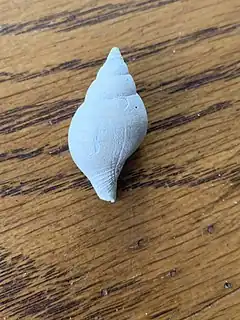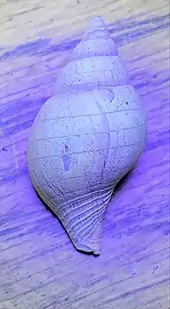Bermont Formation
The Bermont Formation is a geologic formation in Florida. It preserves mostly invertebrate fossils that date back to the Middle Pleistocene. Most of the fossils preserved are extant mollusk shells. It is mined commercially along with similar formations, to produce shell fill for construction.
| Bermont Formation | |
|---|---|
| Stratigraphic range: Middle Pleistocene | |
 A fossil Banded Tulip (Cinctura lilium) from the Bermont Formation | |
| Type | Formation |
| Sub-units | Belle Glade, Okeelanta, and Holey Land |
| Underlies | Fort Thompson Formation |
| Overlies | Caloosahatchee Formation |
| Thickness | 0.6 - 9.0 meters |
| Lithology | |
| Primary | limestone, sand |
| Other | phosphate |
| Location | |
| Region | Florida |
| Country | United States |
A lot of our information on the Bermont Formation comes from commercial mining operations. Due to the nature of Florida's flat landscape, paleontologists rely on commercial interest in mining to gain access to otherwise inaccessible specimens for study. Such is the case with the Bermont Formation's bone bed in the Leisey shell pit.
As is the case with some other formations, UV can sometimes be used to bring out hidden pigmentation in some fossil shells. This is especially useful in telling the difference between some species, which would otherwise be indistinguishable.

Environment of Deposition
The original environment of the deposits has been interpreted as being that of a shallow coastal marine reef, to open brackish waters, with a maximum depth of less than 15 meters. Currently, it is estimated that 10 - 20% of its mollusk species are extinct.
Index Taxa
Index taxa in the Bermont formation currently include Strombus mayacensis, Vasum floridanum, Fusinus watermani, Fasciolaria okeechobeensis, and Miltha carmenae.
References
- Various Contributors to the Paleobiology Database. "Fossilworks: Gateway to the Paleobiology Database". Retrieved 17 December 2021.
- ROGER W. PORTELL and B. ALEX KITTLE Database. "Florida Fossil Invertebrates Database" (PDF). Archived (PDF) from the original on 2017-03-22.
- "OVERVIEW OF THE GEOLOGY AND VERTEBRATE BIOCHRONOLOGY OF THE LEISEY SHELL PIT LOCAL FAUNA, HILLSBOROUGH COUNTY, FLORIDA Database" (PDF).
- Hendricks, J. R. (2015). "Glowing Seashells: Diversity of Fossilized Coloration Patterns on Coral Reef-Associated Cone Snail (Gastropoda: Conidae) Shells from the Neogene of the Dominican Republic Database". PLOS ONE. 10 (4): e0120924. doi:10.1371/journal.pone.0120924. PMC 4382297. PMID 25830769.